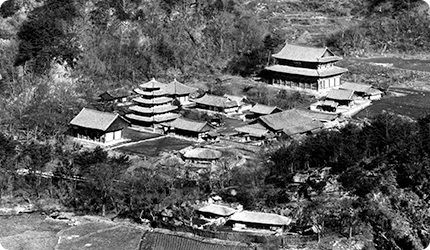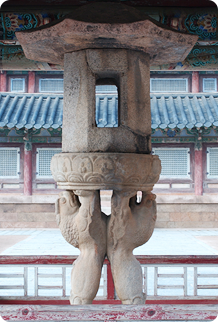Buddhist Mountain Monasteries in Korea
Beopjusa Temple
Beopjusa Temple
Introduction
Natural Environment
History
Temple Layout
Cultural Properties
Information
History of Beopjusa Temple
-
- Beopjusa Temple, founded by Spiritual Patriarch Uisin in 552, was reconstructed in 720 (19th year of King Seongdeok’s reign). Based on Gwandong-pungakbaryeon-suseokgi of Samguk-yusa (Legends and History of Korea's Three Kingdoms), it is believed to have been rebuilt once again by Precepts Master Jinpyo and his disciple Yeongsim around 760.
It is speculated that it was called Gilsangsa Temple in the Unified Silla Period, during which the temple worshiped the Maitreya Buddha according to the teachings of Precepts Master Jinpyo.
Then, it is thought that, with the construction of several buildings on the compound in the 9th century, it established itself as the representative temple of Songnisan Mountain, where many monks cultivated the Way.
The supporting evidence behind these theories include the Twin-lion Stone Lantern (National Treasure No. 5) and the Stone Lotus Basin (National Treasure No. 64), which are estimated to date from the Unified Silla Period.
-
 Beopjusa Temple during the Japanese occupational period
Beopjusa Temple during the Japanese occupational period
- Beopjusa Temple underwent considerable development with the patronage of the royal family in the Goryeo Dynasty, and a number of events have been recorded in Beopjusa-sajeokgi. This book in particular is considered essential in examining the history of Beopjusa Temple as many of the records are consistent with those of Goryeosa (History of Goryeo) and Goryeo-sajyeryo (Essentials of Goryeo History). However, in Goryeosa, the name of the temple was consistently recorded as “Songnisa,” and thus, it is believed that the temple was called Songnisa back in the Goryeo Dynasty. According to Beopjusa-sajeokgi, the Iron Flagpole of Beopjusa Temple was first installed in 1006 (9th year of King Mokjong’s reign over Goryeo), but the present-day flagpole is one that was erected after the original was removed under the order of Heungseon Daewongun in the late Joseon Dynasty. Only the flagpole support dates from the Goryeo Dynasty. It is believed that Beopjusa Temple underwent considerable growth in the Goryeo Dynasty after developing close relations with the royal family when Supreme Patriarch Dosaeng, the fifth son of King Munjong and the younger brother to National Preceptor Daegak Uicheon, stayed at the temple. In the late Goryeo Dynasty, several kings including Chungnyeol, Chungsuk and Gongmin visited the temple. Of particular note, it’s been said King Gongmin sent an envoy to Tongdosa Temple to have the Buddha’s sarira enshrined at Beopjusa Temple, and it’s been said that the sarira was enshrined in the stupa situated behind the present-day Neunginjeon Hall.
- Beopjusa Temple, founded by Spiritual Patriarch Uisin in 552, was reconstructed in 720 (19th year of King Seongdeok’s reign). Based on Gwandong-pungakbaryeon-suseokgi of Samguk-yusa (Legends and History of Korea's Three Kingdoms), it is believed to have been rebuilt once again by Precepts Master Jinpyo and his disciple Yeongsim around 760.
It is speculated that it was called Gilsangsa Temple in the Unified Silla Period, during which the temple worshiped the Maitreya Buddha according to the teachings of Precepts Master Jinpyo.
Then, it is thought that, with the construction of several buildings on the compound in the 9th century, it established itself as the representative temple of Songnisan Mountain, where many monks cultivated the Way.
-
-
 Twin-lion Stone Lantern at Beopjusa Temple
Twin-lion Stone Lantern at Beopjusa Temple
- Beopjusa Temple maintained close relations with the royal family even in the Joseon Dynasty, and received patronage of King Sejo.
Unfortunately, however, most of the buildings were destroyed by fire during the Japanese invasions of Korea in 1592 and 1597.
Then, finally in 1626 (4th year of King Injo’s reign), the major temple buildings were reconstructed by Great Monk Samyeong, and Beopju-sajeokgi was compiled in 1630.
Later during King Yeongjo’s reign, the Wondang (a Dharma Hall housing a portrait or a tablet of a deceased person to pray for repose of the spirit) was built for Royal Noble Consort Yeong of the Yi clan (Yeongbin Yi), which shows that the temple maintained amicable ties with the royal family. In 1851 (2nd year of King Cheoljong’s reign), Prime Minister Gwon Don-in exerted his power and authority to rebuild the temple at the state level.
In 1872 (9th year of King Gojong’s reign), the two-story Yonghwabojeon Hall, which had been seated on the site of the present-day Colossal Bronze Statue of the Buddha, was demolished. Maitreya sculptures began to be made in 1939, but the project was suspended before it was finished. It was resumed years later, and it was finally completed in 1964. The gold plating work on the Maitreya was conducted in 2002.
-
Chronological Table
| Time Period | Description |
|---|---|
| 553 | Beopjusa Temple is founded by Spiritual Patriarch Uisin |
| Around 760 | Precepts Master Jinpyo and disciple Yeongsim, etc. rebuilds the temple |
| During King Sukjong’s reign over Goryeo | Supreme Patriarch Dosaeng serves as the Abbot |
| During King Injong’s reign over Goryeo | The King holds a jeomchal assembly at the temple and orders Kim Bu-sik to build Songnisa Jeomchal Assembly Center |
| During King Wonjong’s reign over Goryeo | Great Monk Jajeongmisu stays at the temple |
| 1281 | The King visits the temple and pay homage to Buddha at Sanhojeon Hall, and King Chungsuk visits the temple afterwards |
| 1363 | The King sends an envoy to Tongdosa in Yangsan to enshrine sarira at Beopjusa |
| During King Sejo’s reign over Joseon | Great Monk Sinmi stays at the temple and initiates a large-scale rebuilding project |
| 1592 | Most of the temple buildings become destroyed during the Japanese invasion of Korea in 1592 |
| 1605-26 | The temple is reconstructed by Great Monk Samyeong |
| 1630 | Beopjusa-sajeokgi is compiled |
| 1636-40 | Seon Master Byeogam Gakseong rebuilds the destroyed temple |
| 1851 | Gwon Don-in initiates a rebuilding project at the state level |
| 1872 | The 2-story Yonghwabojeon Hall is demolished (on the present-day site for Gilt-Bronze Statue of Maitreya) |
| 1939 | Creation of the Maitreya sculptures begins (The project to make 80 Maitreya sculptures is commissioned by Jang Seok-jang, the Abbot of Beopjusa, with donations made by Gim Yeong-gon of Taein, but the project gets suspended due to the premature death of Sculptor Gim Bok-jin) |
| 1963 | The Maitreya sculpture project is resumed with a contribution made by President Park Chung-hee in March and finished a year later |
| 2002 | The colossal image of Maitreya is plated with gold |
